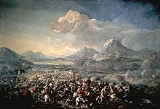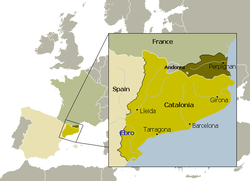
Catalan Revolt
Encyclopedia
The Catalan Revolt affected a large part of the Catalan
Principality of Catalonia
between the years of 1640 and 1659. It had an enduring effect in the Treaty of the Pyrenees
(1659), which ceded the county of Roussillon
and the northern half of the county of Cerdanya
to France (see French Cerdagne
), thereby splitting the Catalan population of the Aragonese crown.
. Count-Duke Olivares
, the chief minister of Philip IV
, had been overusing Catalan resources in his wars against France. Catalan peasants, who were forced to quarter Castilian troops, responded on Corpus Christi day
, May 1640, with an uprising known as 'Bloody Corpus' (Catalan Corpus de Sang
), under the slogans "Long live the faith of Christ!", "Long live the king , our lord", "Long live the land, death to bad government". This 'Bloody Corpus' which began with the death of a segador, a reaper, and led to the somewhat mysterious death of Dalmau de Queralt, Count of Santa Coloma
and Spanish viceroy of Catalonia, marked the beginning of the conflict. The irregular militia involved were known as 'Miquelets
'.
The situation took Olivares by surprise, with most of the Spanish army fighting on other fronts far from Catalonia.
Pau Claris, head of the Generalitat of Catalonia
, turned the social unrest of the Catalans into a political cause and proclaimed a Catalan Republic
.
(January 26, 1641). A little later, the death of Pau Claris created a difficult local and international situation, which resulted in the proclamation of Louis XIII of France
as sovereign count of Barcelona as Lluís I de Barcelona. For the next decade the Catalans and French fought as allies, until in 1652 a Spanish offensive captured Barcelona bringing the Catalan capital under Spanish control again. Irregular resistance continued for several years afterwards, but the successful siege of Barcelona marked the end of major fighting.
 The conflict extended beyond the Peace of Westphalia
The conflict extended beyond the Peace of Westphalia
, which concluded the Thirty Years' War
in 1648, with the confrontation between two sovereigns and two Generalitats, one based in Barcelona, under the control of Spain and the other in Perpinyà (Perpignan
), under the occupation of France. In 1652 the French authorities renounced Catalonia, but held control of Roussillon, thereby leading to the signing of the Treaty of the Pyrenees
in 1659.
Crown of Aragon
The Crown of Aragon Corona d'Aragón Corona d'Aragó Corona Aragonum controlling a large portion of the present-day eastern Spain and southeastern France, as well as some of the major islands and mainland possessions stretching across the Mediterranean as far as Greece...
Principality of Catalonia
Principality of Catalonia
The Principality of Catalonia , is a historic territory in the northeastern Iberian Peninsula, mostly in Spain and with an adjoining portion in southern France....
between the years of 1640 and 1659. It had an enduring effect in the Treaty of the Pyrenees
Treaty of the Pyrenees
The Treaty of the Pyrenees was signed to end the 1635 to 1659 war between France and Spain, a war that was initially a part of the wider Thirty Years' War. It was signed on Pheasant Island, a river island on the border between the two countries...
(1659), which ceded the county of Roussillon
Roussillon
Roussillon is one of the historical counties of the former Principality of Catalonia, corresponding roughly to the present-day southern French département of Pyrénées-Orientales...
and the northern half of the county of Cerdanya
Cerdanya
Cerdanya is a natural comarca and historical region of the eastern Pyrenees divided between France and Spain. Historically it has been one of the counties of Catalonia....
to France (see French Cerdagne
French Cerdagne
French Cerdagne is the northern half of Cerdanya, which came under French control as a result of the Treaty of the Pyrenees in 1659, while the southern half remained in Spain . Catalonians often refer to French Cerdagne as Upper Cerdanya...
), thereby splitting the Catalan population of the Aragonese crown.
Background
The war had its roots in the discomfort generated in Catalan society by the presence of Castilian troops during the wars between France and Spain as part of the Thirty Years' WarThirty Years' War
The Thirty Years' War was fought primarily in what is now Germany, and at various points involved most countries in Europe. It was one of the most destructive conflicts in European history....
. Count-Duke Olivares
Olivares
Olivarez might refer to:* Olivarez, Seville, a municipality in the Seville province of Spain* House of Olivares* Gaspar de Guzmán, Count-Duke of Olivares, seventeenth-century Spanish statesman* Olivarez de Júcar, Spain, a municipality in Cuenca...
, the chief minister of Philip IV
Philip IV of Spain
Philip IV was King of Spain between 1621 and 1665, sovereign of the Spanish Netherlands, and King of Portugal until 1640...
, had been overusing Catalan resources in his wars against France. Catalan peasants, who were forced to quarter Castilian troops, responded on Corpus Christi day
Corpus Christi (feast)
Corpus Christi is a Latin Rite solemnity, now designated the solemnity of The Most Holy Body and Blood of Christ . It is also celebrated in some Anglican, Lutheran and Old Catholic Churches. Like Trinity Sunday and the Solemnity of Christ the King, it does not commemorate a particular event in...
, May 1640, with an uprising known as 'Bloody Corpus' (Catalan Corpus de Sang
Corpus de Sang
The Corpus de Sang was a riot which took place in Barcelona on 7 June 1640, during Corpus Christi, which marked a turning point in the development of the Reapers' War. The riot was between a group of harvesters and some local Barcelonians, during which one harvester was badly hurt....
), under the slogans "Long live the faith of Christ!", "Long live the king , our lord", "Long live the land, death to bad government". This 'Bloody Corpus' which began with the death of a segador, a reaper, and led to the somewhat mysterious death of Dalmau de Queralt, Count of Santa Coloma
Dalmau de Queralt, Count of Santa Coloma
Dalmau de Queralt i de Codina, Count of Santa Coloma , was a Catalan noble, viceroy of Catalonia between 1638 and 1640, who was assassinated by Catalan rebels at the beginning of the Catalan Revolt.-Biography:...
and Spanish viceroy of Catalonia, marked the beginning of the conflict. The irregular militia involved were known as 'Miquelets
Miquelet (militia)
Miquelets or Micalets were irregular Catalan and Valencian militia. The name is a diminutive of Michael; it is claimed it comes from Miquel or Miquelot de Prats, a Catalan mercenary captain in the service of Cesare Borgia...
'.
The situation took Olivares by surprise, with most of the Spanish army fighting on other fronts far from Catalonia.
Pau Claris, head of the Generalitat of Catalonia
Generalitat de Catalunya
The Generalitat of Catalonia is the institution under which the autonomous community of Catalonia is politically organised. It consists of the Parliament, the President of the Generalitat of Catalonia and the Government of Catalonia....
, turned the social unrest of the Catalans into a political cause and proclaimed a Catalan Republic
Catalan Republic
The Catalan Republic also known as the Catalan State, is an unrecognized state claimed by the Catalan independentism or nationalism. The Catalan Republic has been proclaimed at least four times:* In 1641, by Pau Claris....
.
Conflict
The Generalitat obtained an important military victory in the Battle of MontjuïcBattle of Montjuïc (1641)
Battle of Montjuïc took place on 26 January 1641 during the Catalan Revolt. A Spanish force under Pedro Fajardo launched an attack on a Catalan rebel force, made up mainly of Miquelet militias led by Francesc de Tamarit, and their French allies....
(January 26, 1641). A little later, the death of Pau Claris created a difficult local and international situation, which resulted in the proclamation of Louis XIII of France
Louis XIII of France
Louis XIII was a Bourbon monarch who ruled as King of France and of Navarre from 1610 to 1643.Louis was only eight years old when he succeeded his father. His mother, Marie de Medici, acted as regent during Louis' minority...
as sovereign count of Barcelona as Lluís I de Barcelona. For the next decade the Catalans and French fought as allies, until in 1652 a Spanish offensive captured Barcelona bringing the Catalan capital under Spanish control again. Irregular resistance continued for several years afterwards, but the successful siege of Barcelona marked the end of major fighting.
Resolution

Peace of Westphalia
The Peace of Westphalia was a series of peace treaties signed between May and October of 1648 in Osnabrück and Münster. These treaties ended the Thirty Years' War in the Holy Roman Empire, and the Eighty Years' War between Spain and the Dutch Republic, with Spain formally recognizing the...
, which concluded the Thirty Years' War
Thirty Years' War
The Thirty Years' War was fought primarily in what is now Germany, and at various points involved most countries in Europe. It was one of the most destructive conflicts in European history....
in 1648, with the confrontation between two sovereigns and two Generalitats, one based in Barcelona, under the control of Spain and the other in Perpinyà (Perpignan
Perpignan
-Sport:Perpignan is a rugby stronghold: their rugby union side, USA Perpignan, is a regular competitor in the Heineken Cup and seven times champion of the Top 14 , while their rugby league side plays in the engage Super League under the name Catalans Dragons.-Culture:Since 2004, every year in the...
), under the occupation of France. In 1652 the French authorities renounced Catalonia, but held control of Roussillon, thereby leading to the signing of the Treaty of the Pyrenees
Treaty of the Pyrenees
The Treaty of the Pyrenees was signed to end the 1635 to 1659 war between France and Spain, a war that was initially a part of the wider Thirty Years' War. It was signed on Pheasant Island, a river island on the border between the two countries...
in 1659.
See also
- "Els SegadorsEls Segadors-History:Though the original song dates in the oral tradition to 1640, its modern lyrics were written by Emili Guanyavents, who won a controversial competition in 1899. The music was standardized by Francesc Alió in 1892...
" ("The Reapers"), the current anthem of Catalonia. The current lyrics are from 1899. - Revolt of the Barretines, another Catalonian revolt from 1687–1689.
Sources
- J.H. Elliott. The Revolt of the Catalans: a Study in the Decline of Spain (1598-1640). Cambridge, 1963.
- J. Sanabre. La acción de Francia en Cataluña en la pugna por la hegemonía de Europa (1640-1659). Barcelona, 1956. Still indispensable for its detailed coverage of the events from 1640/41 and later.

